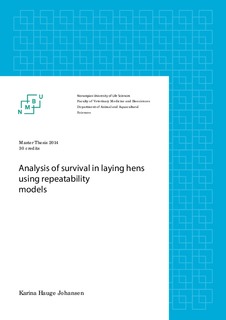| dc.description.abstract | The commercial egg production is a huge and growing industry, which faces some important animal welfare issues. Feather pecking and cannibalistic behaviour are a multi-factorial problem that have a huge negative impact on the farmers' economy, as many layers die before the laying period is over. The solution to this problem has so far been beak trimming, which is also publicly regarded as a welfare issue. In addition to better management, breeding is starting to be looked upon as a more permanent solution, as the destructive behaviour has a heritable component. The challenge today is to find a breeding model that accurately predicts breeding values on the parental animals from survival data of the progeny. In traditional models, usually only the direct effect of the animal itself has been accounted for, neglecting the genetically inheritable social component that exists between grouped animals. In this thesis, survival records (0/1) from 6916 pure bred layers were analyzed using 6 different models. Model 1: Sire direct effects model, 2: Sire direct-random cage effects model, 3: Sire direct-indirect-random cage effects model, 4: Sire-Dam direct-indirect-random cage effects model, 5: Repeatability direct-indirect-random cage effects model, 6: Repeatability direct-indirect-random cage effects model with time dependent social effects. Genetic parameters were estimated, where the heritability ranged between 0.0121 and 0.1169, and the correlation between direct and indirect genetic effects ranged from -0.3704 to -0.4898. Cross validation of the models showed that for analyzing this type of survival data, the Sire-Dam direct-indirect-random cage effects model gave the most accurate breeding values compared to the other models. A Sire-Dam model can therefore be a good tool when breeding towards low-pecking strains of layers, where damaging behaviour is eliminated and beak trimming is unnecessary. | nb_NO |
